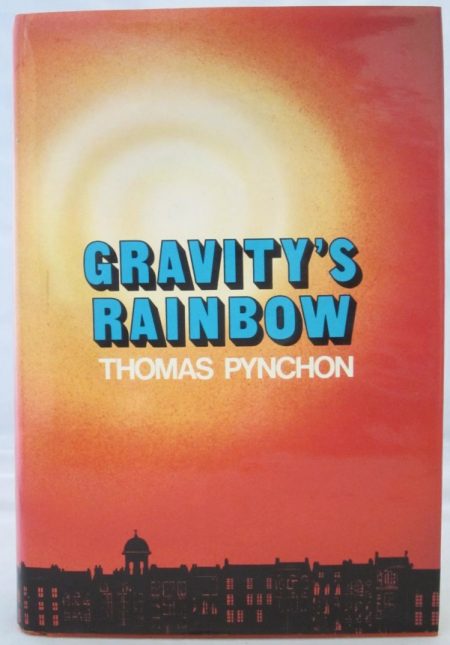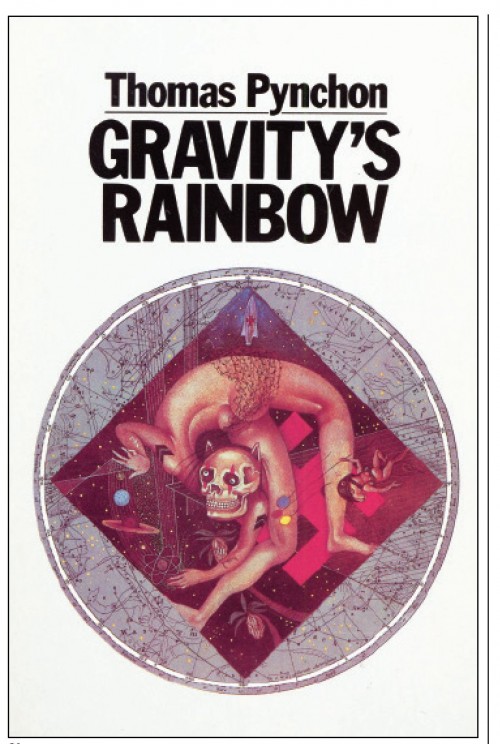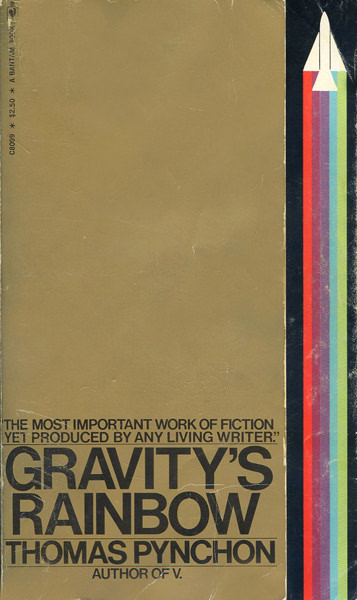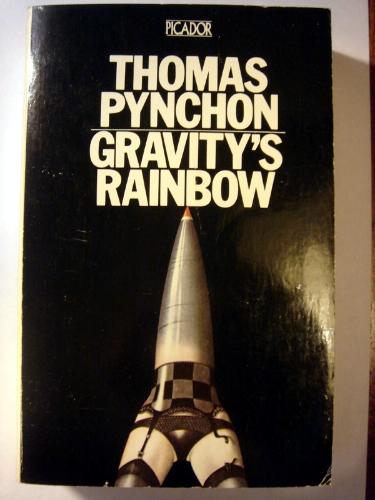SEMIOPUNK (32)
By:
April 3, 2025

An irregular, ongoing series of posts dedicated to surfacing examples (and predecessors) of the sf subgenre that HILOBROW was the first to name “semiopunk.”
BABEL (2022) | BABEL-17 (1966) | CAMP CONCENTRATION (1968) | A CANTICLE FOR LEIBOWITZ (1959) | CAT’S CRADLE (1963) | COSMONAUT KEEP (2000) | THE DIFFERENT GIRL (2013) | DOOM PATROL (1987–91) | THE EINSTEIN INTERSECTION (1967) | EMBASSYTOWN (2011) | ENGINE SUMMER (1979) | EXPLOITS AND OPINIONS OF DR. FAUSTROLL, PATAPHYSICIAN (1911) | FEERSUM ENDJINN (1994) | FLATLAND (1884) | FRIDAY (1982) | LE GARAGE HERMÉTIQUE (1976–79) | THE GLASS BEAD GAME (1943) | GLASSHOUSE (2006) | GRAVITY’S RAINBOW (1973) | THE HAMPDENSHIRE WONDER (1911) | LORD OF LIGHT (1967) | THE MAN WITH SIX SENSES (1927) | THE MOUNTAIN IN THE SEA (2022) | NINEFOX GAMBIT (2016) | ODD JOHN (1935) | PATTERN RECOGNITION (2003) | THE PLAYER OF GAMES (1988) | RIDDLEY WALKER (1980) | RODERICK (1980–83) | SNOW CRASH (1992) | THE SOFT MACHINE (1961) | SOLARIS (1961) | THE SPACE MERCHANTS (1953) | THE THREE STIGMATA OF PALMER ELDRITCH (1964) | TIME OUT OF JOINT (1959) | UBIK (1969) | VALIS (1981) | A VOYAGE TO ARCTURUS (1920) | VURT (1993) | WHITE NOISE (1985).
GRAVITY’S RAINBOW
I knew that I couldn’t/wouldn’t read Gravity’s Rainbow — Thomas Pynchon’s 1973 postmodernist epic, the many subplots of which concern, directly or indirectly, the secret development and deployment of a rocket by the Nazis near the end of World War II; the theme of which is a knotty philosophical one having to do with what Adorno and Horkheimer named the “dialectic of Enlightenment”; and the political point of which is to exhume the dark history of the present (i.e., 1973). Not on my own, anyway. So I recruited Katie Hennessey, a good friend with whom I was working as a courier, to read it too. This was in the winter of 1989–90. A couple of times a week, for several months, we’d meet at Doyle’s, a bar in Boston’s Jamaica Plain neighborhood, and discuss the book. It worked! Or so I thought. Many years later, Katie would confess that she’d only pretended to read Gravity’s Rainbow. Which makes me wonder: Was I faking it too?
By 1989, I’d already devoured V. (1963) and The Crying of Lot 49 (1966) — the latter in Bantam’s groovy 1967 paperback edition, which Katie’s father had grudgingly loaned me, knowing full well that he’d never lay eyes on it again. (Vineland and Pynchon’s other post-Gravity’s Rainbow novels hadn’t yet appeared.) So I was prepared, or so I believed, for the Gravity’s Rainbow experience: the waging of “a continual war between random and compulsive energies,” as Jonathan Rosenbaum put it in his bravura contemporary review of the book, one that prevents Pynchon’s brilliant, paranoid, antic, absurdist countercultural novels “from being either complete formed or completely formless.”
Indeed, Pynchon’s PKD-like tendency towards obsessing (droning tediously, at least some of the time) about ever-more complex theories and suspicions is thankfully interrupted by digressions of every sort. There are deep dives down various social, cultural, economic, and historical rabbit holes; back stories for main characters and (some 400) minor characters; song and dance routines, limericks, shaggy-dog stories, and pun-supporting flights of fancy. (We may be bewildered, one would like to say, but never bored. Except at several points, let’s be honest, Gravity’s Rainbow is boring.) Despite my self-prescribed exposure therapy, I’ve always struggled to get through the book. Please bear this in mind as you read the following necessarily inadequate notes about this major work of semiopunk sf.
Inspired in part by Joseph Heller’s Catch-22 (1961), Gravity’s Rainbow, the plot of which begins in 1944, is a Vietnam War-era commentary on the senselessness of modern warfare. The story’s protagonist, or so we’re at first led to believe, is Lieutenant Tyrone Slothrop, an American working for Allied Intelligence in London. Slothrop, who as a baby (we’ll discover) was experimented on by a German behavioral psychologist and chemical engineer who conditioned him to get an erection in the presence of a stimulus — perhaps the sci-fi substance Imipolex-G — is an agent of Allied Clearing House, Technical Units, Northern Germany (ACHTUNG) in London, and tasked with investigating Germany’s deployment of the world’s first long-range guided ballistic missile: the V-2. (The scientist who’d experimented on Slothrop is now a Nazi rocket scientist.) Employees of a fictional top-secret psychological warfare agency called PISCES investigate Slothrop’s map of his (presumed) sexual encounters in London, finding that each location appears to precede a V-2 rocket strike in the same place by several days. Is there a connection here? Maybe, maybe not; this is one of many MacGuffins.
Discovering that he is being manipulated, Slothrop takes off on an undercover pilgrimage across sections of Switzerland and Germany. What does Margherita Erdmann, former star of a traveling sado-masochistic sex show, know about the device? Why do the Schwarzkommando, African rocket technicians brought to Europe by German colonials, worship the V-2? Why is Slothrop being tailed by Major Duane Marvy, a sadistic American, and Vaslav Tchitcherine, a drug-addled Soviet intelligence officer? His quest to track down a unique, Imipolex-G-enabled V-2 known as “SG-00000,” and his effort to deconstruct his own childhood and later life, send him on a journey that will reveal the corruption and power struggles around World War II’s end and aftermath — especially surrounding the development of military technology.

Like Pynchon’s Mason & Dixon (1997), and Against the Day (2006), Gravity’s Rainbow weighs the entire project of modern Western civilization in the balance, and finds it wanting. The novel’s military-industrial complex stuff is thoroughly researched and mostly factual. Though Slothrop himself is very much a creature of the American establishment (old New England family, a Harvard classmate of JFK’s), his countercultural quest for the truth (one that involves sexual promiscuousness and drug use, thus suggesting that the Sixties weren’t all that revolutionary) makes him a kind of proto-Yippie. He questions the structure of the American social order, and his revelations suggest that only an antiauthoritarian society based on communalism and cooperation can avoid the corruption of political power.
All of which sounds very progressive and admirable, but…. Because Pynchon takes pains to ensure that we’re left wondering how much of Slothrop’s story and investigation are the products of a paranoid mind, Gravity’s Rainbow requires us to develop a skeptical attitude not only towards the West but consensus reality. Also, Pynchon presciently suggests — versus historical accounts of WWII that depict it as a simple Good Guys vs. Bad Guys conflict — that the fight against fascism will never end. Right-wing politics will continue to flourish, because all human-run institutions thrive on dehumanization. Slothrop is last spotted grooving out to a vision of a rainbow: “his chest fills and he stands crying, not a thing in his head, just feeling natural….” Not exactly a progressive rallying cry, right?
As HILOBROW friend Anthony Miller pointed out to me in a recent email exchange, as a character Slothrop disappears from Gravity’s Rainbow “with the coming of the Counterforce (both the book section and the larger idea/entity).” (Thanks also, to Anthony, for bringing the cover shown above to my attention. Never saw this one before.) Slothrop now becomes, to quote one of the thousands of Pynchon exegetes on Reddit’s r/ThomasPynchon thread:
a sort of body-less spiritual being that at various points takes the form of pure music (as referenced in the harmonica notes in the first chapter of part 4 and the blues heard by Eddie Pensiero in the Byron sequence), “scrawled lines of charcoal on a wall, voices down a chimney, some human being out on the road”, a face on an album cover, “the hostile light of the sky, the darkness of the sea…
All of which reminds this semiopunk sf fan, anyway, of Philip K. Dick’s Ubik (1969).
The book’s title refers to the parabolic trajectory of a V-2, as well as to the introduction of randomness into physics via quantum mechanics. My fellow semioticians ought to appreciate Gravity’s Rainbow, I think, because it rejects over-simple answers to vertiginously complex questions.
As HILOBROW friend Tom McCarthy wrote in a New York Times essay on Gravity’s Rainbow, not long before the publication of his sf-ish, semiotician-mocking literary novel Satin Island:
In this novel about clarity and obfuscation, about the Enlightenment’s most dazzling and dark consequences, light and its color spectrum play a central role. Light… is always patterned — trellised, meshed by lattices and trusswork; it, too, promises and withholds meaning, covering landscapes “in misty ambivalence” and turning people into “dark fish hiding past angles of refraction.”
McCarthy could be describing a semiotic schema, in this passage: a lattice-work sufficiently complex, that is, to capture the “misty ambivalence” of how meaning operates within a semiosphere.
McCarthy’s essay goes on to limn the system of mutually and reciprocally defining terms within the Gravity’s Rainbow semiosphere:
Politically, the universe of “Gravity’s Rainbow” separates into two sides, opposed yet uncomfortably codependent: on the right, the “System”; on the left, the “Counterforce” (for which read “counterculture”). […] The System, when it craves enlightenment, has its ledgers all to hand, whereas the Counterforce has to fall back on “dreams, psychic flashes, omens, cryptographies, drug-epistemologies, all dancing on a ground of terror, contradiction, absurdity” (a perfect description of this novel). But they’re both after the same thing: the epiphanic “holy Center” or “Absolute Zero” whose “pure light” is so total it blinds.
“If there is something comforting — religious, if you want — about paranoia,” Slothrop muses, in one of the book’s most often-quoted passages, “there is still also anti-paranoia, where nothing is connected to anything, a condition not many of us can bear for long.” This is the dialectic of Enlightenment — or Adorno’s negative dialectics, really. Adorno’s purpose (which, like Slothrop’s, was crucially informed by WWII and its aftermath) was to overcome the formal logical limits of totalizing, Enlightenment-style, progressive dialectics by foregrounding the limits of knowledge. Pynchon’s fictional semiosphere — which might best be diagrammed, perhaps, via an Imipolex-G-schema — is a non-totalizing, negative-dialectical, post-structuralist one. Which is to say: It’s very much a structuralist scheme, while one that remains sensitively attuned to structuralism’s limitations.
“The ordered swirl of houses and streets, from this high angle, sprang at her now with the same unexpected, astonishing clarity as the circuit card had,” Oedipa Maas discovers in The Crying of Lot 49. “Though she knew even less about radios than about Southern Californians, there were to both outward patterns a hieroglyphic sense of concealed meaning, of an intent to communicate.” Has this discontented California housewife uncovered a centuries-old conflict between two mail distribution companies? Or is she perhaps merely detecting signals where there is only noise? Pynchon refuses to answer this sort of query in Gravity’s Rainbow, a story in which ice-cracks form “graffiti… a legend to be deciphered,” raindrops splash in asterisks, inviting us “to look down at the bottom of the text of the day,” and shit cakes the walls of sewers in “patterns thick with meaning.”
One can understand why the Pulitzer Advisory Board dismissed Gravity’s Rainbow as unreadable and obscene; but one also recognizes it as a preposterous, experimental, anti-fascist work of genius like no other.
Gravity’s Rainbow won the National Book Award for fiction in 1974; and it was nominated for science fiction’s Nebula Award, losing out to Arthur C. Clarke’s far more straightforwardly sf novel Rendezvous with Rama. Also! Although the Pulitzer Prize jury selected Gravity’s Rainbow to receive the fiction prize, the Pulitzer Advisory Board overruled them, electing not to give an award at all in order to avoid honoring an “unreadable,” “turgid,” and “obscene” work of literature.
The book is now “vintage,” though — a much-admired (if little-read) classic. Yet… although Gravity’s Rainbow optimistically insists — more at the level of form than content — that another world is possible, and demands that we develop the capacity to “imagine a world that is richer and stranger than can be encompassed in a conventionally rationalist vision” (as M. Keith Booker wrote in a Los Angeles Review of Books essay commemorating the novel’s 50th anniversary), it ends with a pessimistic “vision of the United States’ heedless stumble towards destruction,” in Booker’s description, “as the audience in [a Los Angeles movie] theater prepares to meet its collective death with a follow-the-bouncing-ball singalong.”
Yikes! Why does this vintage novel feel so… contemporary?
JOSH GLENN’S *BEST ADVENTURES* LISTS: BEST 250 ADVENTURES OF THE 20TH CENTURY | 100 BEST OUGHTS ADVENTURES | 100 BEST RADIUM AGE (PROTO-)SCI-FI ADVENTURES | 100 BEST TEENS ADVENTURES | 100 BEST TWENTIES ADVENTURES | 100 BEST THIRTIES ADVENTURES | 75 BEST GOLDEN AGE SCI-FI ADVENTURES | 100 BEST FORTIES ADVENTURES | 100 BEST FIFTIES ADVENTURES | 100 BEST SIXTIES ADVENTURES | 75 BEST NEW WAVE SCI FI ADVENTURES | 100 BEST SEVENTIES ADVENTURES | 100 BEST EIGHTIES ADVENTURES | 75 BEST DIAMOND AGE SCI-FI ADVENTURES | 100 BEST NINETIES ADVENTURES | 75 BEST HADRON AGE SCI-FI ADVENTURES.



